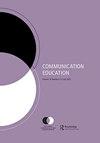名字里有什么?身份意识和促进是未来沟通教育和教学沟通的基础
IF 0.8
Q3 COMMUNICATION
引用次数: 0
摘要
传播学科中有一个普遍的信条,即我们的工作——无论是研究、教学还是服务——对于改善个人和社区的个人和职业生活,以及当地和全球社会至关重要。事实上,国家传播协会(National Communication Association)的使命声明(n.d.)宣称,我们的领域“促进对公共和私人生活中沟通重要性的广泛认识,运用有能力的沟通来改善人类生活和人际关系的质量,以及利用知识和沟通来解决人类问题。”实现沟通学科这一使命的基础是有效教授沟通(例如,概念、理论、技能)的能力。整个学科建立在这样一个前提上:“传播学的研究和教学与其他学科[不同],[应该]有自己的制度和知识合法性”(National Communication Association, n.d)。致力于传播学、教育和教学传播学的研究和实践的子领域解决了这一问题。除了传播学的教学外,该子领域还致力于“理解传播在学术内外不同空间、结构和互动中的教学过程中的作用”(又称教学传播)的研究和实践(Taylor & Francis Online, n.d)。因此,我们子领域的工作绝对是该学科的使命、愿景和价值观的核心(例如,Morreale等人,2023)。三种主要的学科期刊——《传播教育》、《传播教师》和《传播教育学杂志》——作为专门出版一系列传播教育和教学传播研究的渠道而存在(Taylor & Francis Online, n.d)。传播教育和教学传播不仅是该学科的历史基础,而且它们仍然是整个传播学科当前研究和实践的中心焦点(例如,Morreale等人,2014;迈尔斯,2010)。本文章由计算机程序翻译,如有差异,请以英文原文为准。
What’s in a name? Identity awareness and promotion as fundamental to the future of communication education and instructional communication
A pervasive mantra across the Communication discipline proclaims the critical importance of our work—whether it be research, teaching, or service—to improve the personal and professional lives of individuals and communities, as well as local and global societies. In fact, the mission statement of the National Communication Association (n.d.) declares that our field “promotes the widespread appreciation of the importance of communication in public and private life, the application of competent communication to improve the quality of human life and relationships, and the use of knowledge and communication to solve human problems.” Fundamental to achieving this mission of the Communication discipline is the capacity to teach communication (e.g., concepts, theories, skills) effectively. The entire discipline was founded on the premise that “the study and teaching of Communication [is] distinct from other disciplines [and deserves] its own institutional and intellectual legitimacy” (National Communication Association, n.d.). The subfield devoted to research and practice in communication education and instructional communication addresses this exigence. In addition to the teaching of communication, the subfield is also devoted to the research and practice of “understanding the role of communication in the teaching and learning process in diverse spaces, structures, and interactions, within and outside of academia” (a.k.a. instructional communication) (Taylor & Francis Online, n.d.). Thus, the work of our subfield is most definitely central to the mission, vision, and values of the discipline (e.g., Morreale et al., 2023). Three major discipline-specific journals–Communication Education, Communication Teacher, and the Journal of Communication Pedagogy—exist as outlets created intentionally for publishing an array of communication education and instructional communication research (Taylor & Francis Online, n.d.). Not only are communication education and instructional communication visionary constructs that ground the discipline historically, but they continue to be central foci in current research and practice throughout the Communication discipline (e.g., Morreale et al., 2014; Myers, 2010).
求助全文
通过发布文献求助,成功后即可免费获取论文全文。
去求助
来源期刊

COMMUNICATION EDUCATION
EDUCATION & EDUCATIONAL RESEARCH-
CiteScore
3.10
自引率
34.80%
发文量
47
期刊介绍:
Communication Education is a peer-reviewed publication of the National Communication Association. Communication Education publishes original scholarship that advances understanding of the role of communication in the teaching and learning process in diverse spaces, structures, and interactions, within and outside of academia. Communication Education welcomes scholarship from diverse perspectives and methodologies, including quantitative, qualitative, and critical/textual approaches. All submissions must be methodologically rigorous and theoretically grounded and geared toward advancing knowledge production in communication, teaching, and learning. Scholarship in Communication Education addresses the intersections of communication, teaching, and learning related to topics and contexts that include but are not limited to: • student/teacher relationships • student/teacher characteristics • student/teacher identity construction • student learning outcomes • student engagement • diversity, inclusion, and difference • social justice • instructional technology/social media • the basic communication course • service learning • communication across the curriculum • communication instruction in business and the professions • communication instruction in civic arenas In addition to articles, the journal will publish occasional scholarly exchanges on topics related to communication, teaching, and learning, such as: • Analytic review articles: agenda-setting pieces including examinations of key questions about the field • Forum essays: themed pieces for dialogue or debate on current communication, teaching, and learning issues
 求助内容:
求助内容: 应助结果提醒方式:
应助结果提醒方式:


